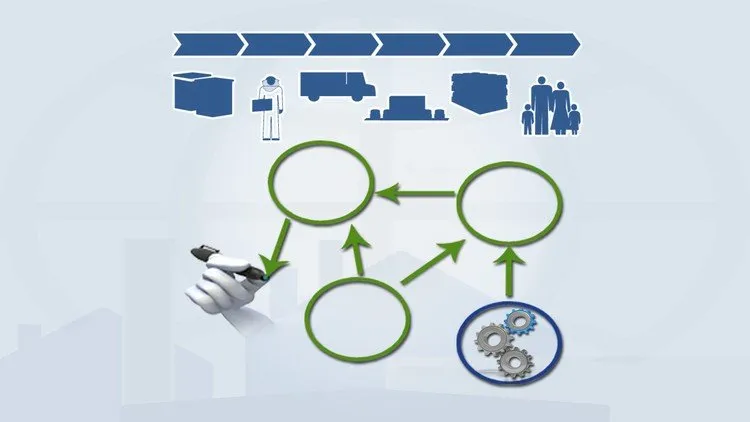Business Analysis: Data Flow Diagrams to Visualize Workflows
Process Modeling Techniques for Requirements Elicitation and Workflow Analysis

Business Analysis: Data Flow Diagrams to Visualize Workflows udemy course free download
Process Modeling Techniques for Requirements Elicitation and Workflow Analysis
What you'll learn:
- Document existing business processes and workflows in Data Flow Diagrams (DFD) to initiate business process analysis
- Defend the need for Data Flow Diagrams, Context Diagrams, and Rigorous Physical Process Models
- Use the right symbols for each type of diagram to ensure a common interpretation by all parties
- Explode a high level Data Flow Diagram to its lower level details to reveal underlying processes and procedures
- Balance DFD’s to identify missing processes and reduce late project change requests
- Use Horizontal Balancing to discover missing data and minimize redundancies
- Document process specifications for functional primitives to guide the solution providers
- Express metadata to reveal informational details that developers need to build the solution
Requirements:
- No technical background required
- Need to express functional requirements
- Desire to understand one or more workflows / business processes
- Interest in the field of business analysis
- No additional materials are required
- The course has no prerequisites
Description:
Learn about Data Flow Diagrams (DFDs), Context-level DFDs, and Rigorous Physical Process Models (RPPM), what they are, why they are important, and who can use them.
Use Data Flow Diagrams to Visualize Workflows
Getting from someone's explanations of how they do their job to usable and accurate workflow descriptions can be a daunting proposition. Understanding current workflows, however, is critical to defining a future IT solution. Just as critical is understanding how data is created and consumed throughout the workflow.
To truly understand problems inherent in a business process or workflow, you need to help the practitioners visualize what they do. Visualization lets them identify better ways of working that remove current restrictions.
Data Flow Diagrams are phenomenal tools for visualization. Working with business experts, you can help them identify problems and inefficiencies they don’t even know they have. These are not people problems; they are process problems. Understanding when and how to create and use Data Flow Diagrams will help you discover and capture the requirements for improving the use of information technology.
Why Should You Take this Course?
In this 90 minute video course, you will learn the benefits of process visualization for the business community, for the one wearing the BA hat, for those tasked with developing the solution, and ultimately for the entire organization.
You will also discover how DFDs are powerful tools for recognizing and eliminating two of the major problems that haunt IT projects, namely Scope Creep and Project Overruns caused by late project change requests.
“Data Flow Diagrams – Simply Put!” uses a concrete business scenario to present a simple, easy-to-learn approach for creating and using Data Flow Diagrams depicting workflow and data manipulation from interviews with Subject Matter Experts.
You will learn how to create a Context-Level Data Flow Diagram and explode relevant process(es) to reveal the nitty-gritty detail (i.e., individual process and data specifications) that developers need to create IT solutions that the business community needs.
The course answers the following questions:
- What is a Data Flow Diagram (DFD)?
- What is a Rigorous Physical Process Model?
- What is a Context-Level DFD?
- Why should I use Data Flow Diagrams?
- What symbols can I use on each type of diagram?
- How can I drill down into a process?
- How can I show internal processes and flows that produce the results?
- What does balancing a Data Flow Diagram mean and what is the business value?
- What is the most efficient approach to balancing a DFD?
- What business value do process specifications offer?
- How can I express detailed specifications for processes and data?
- What is “metadata" and why do you need it?
- What does a fully balanced DFD look like?
- What value does a DFD fragment provide?
Regardless of your job title or role, if you are tasked with communicating a workflow or functional requirements to others, this course is for you.
Who this course is for:
- Business Analysts
- Subject Matter Experts
- Agile Product Owners
- Project Leaders and Managers
- Line Managers
- Systems Analysts
- Software Testers
- Business Architects
- AND "anyone wearing the business analysis hat"
- Machine Learning A-Z™: Hands-On Python & R In Data Science
- React - The Complete Guide (incl Hooks, React Router, Redux)
- Microsoft Excel - Excel from Beginner to Advanced
- Microsoft Excel - Advanced Excel Formulas & Functions
Course Details:
-
1.5 hours on-demand video
-
1 article
-
4 downloadable resources
-
Full lifetime access
-
Access on mobile and TV
-
Certificate of completion
Business Analysis: Data Flow Diagrams to Visualize Workflows udemy courses free download
Process Modeling Techniques for Requirements Elicitation and Workflow Analysis
Demo Link: https://www.udemy.com/course/data-flow-diagrams-simply-put/

